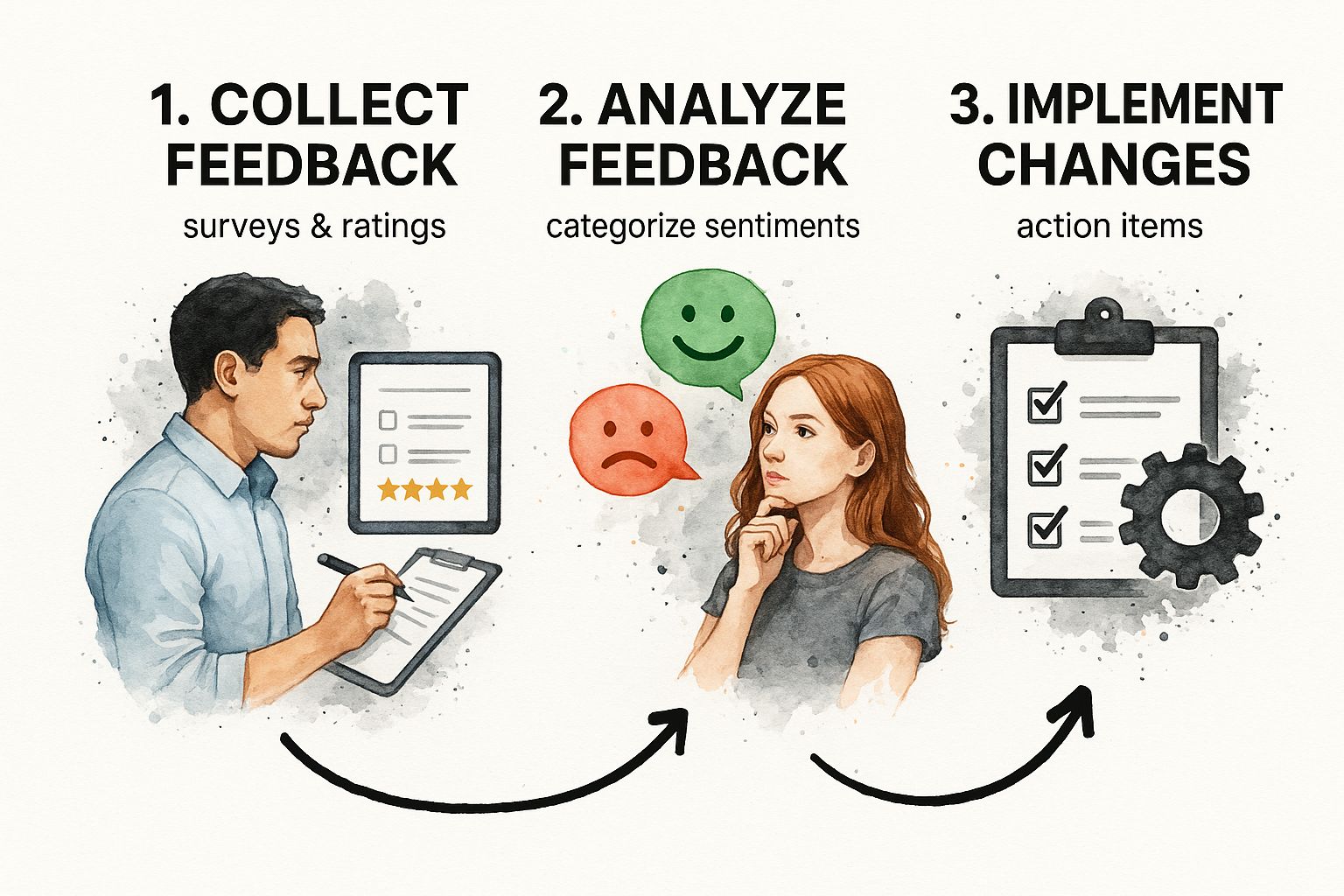Stop Trying to Improve Customer Satisfaction Scores (And Start Listening Instead)
Learn proven strategies on how to improve customer satisfaction scores and boost your business success. Discover expert tips today!
Posted by
Related reading
10 Voice of Customer Examples You Can Actually Use
Stop guessing. See 10 real voice of customer examples from surveys, social media, and support tickets to find out what your customers actually want.
A Founder's Guide to Analyzing Survey Data
A battle-tested approach to analyzing survey data. Learn how to turn raw feedback into actionable insights that drive real business decisions.
Customer Advisory Board: The Founder's Playbook for Avoiding Catastrophic Mistakes
A practical guide to building a customer advisory board that provides honest insights, validates your strategy, and prevents costly product mistakes.
You want to know how to improve your customer satisfaction scores? My advice: stop caring about the score. That number you're so proud of? It’s a ghost. A lagging indicator so flimsy it can tell you you're winning the race right up until you drive off a cliff.
I know because it almost bankrupted me.
My first startup, a SaaS tool for small agencies. We worshipped CSAT. For six months, our scores were a glorious 92% "satisfied." We were gods. We put it in our board deck. We high-fived.
Then revenue fell off a cliff. 15% one month. 10% the next. We were hemorrhaging cash while our dashboard screamed "92% HAPPY!"
Here's the gut punch: we were measuring satisfaction with our support tickets. Our team was friendly and fast. But the product itself? It wasn't solving their core business problem. They were politely satisfied with our support agents right before they churned. We were measuring the quality of the band-aids while the patient was bleeding out.
Ignore your customers, and you’ll be lucky to survive the quarter.
Your CSAT Score Is a Dangerous Vanity Metric
So many founders get trapped in the chasm between satisfaction and loyalty. Satisfaction is cheap. It’s a fleeting feeling about one interaction. Loyalty is a behavior. It's the customer who sticks with you after a botched update because they trust you to make it right.
Satisfaction is a cheap high; loyalty builds empires.
Stop asking, "Is our score good?" and start asking, "What problem did we fail to solve this week?" The number is worthless. The gold is in the comments, the tone of voice, the unstated frustrations hiding behind a polite "4 out of 5."
From Vanity to Actionable Truth
Staring at a dashboard full of green numbers that mean nothing is founder malpractice. Here’s how to tell if you’re looking at vanity or truth.
| The Trap (Vanity Metric) | The Truth (Actionable Insight) |
|---|---|
| CSAT Score: "Our score is 92%!" | Sentiment Analysis: "15% of 'satisfied' customers mention 'confusing navigation'." |
| Ticket Volume: "We closed 500 tickets this week." | Ticket Root Cause: "80 tickets were about the same password reset bug." |
| Response Time: "Our average response is under 2 minutes." | Resolution Time: "It takes 3 days and 5 replies to actually solve the problem." |
| Number of 5-Star Reviews: "We got 20 new 5-star ratings!" | Feature Requests in Reviews: "12 of those 5-star reviews asked for a Zapier integration." |
One side feels good. The other gives you a to-do list to make your product better. The path to improving customer satisfaction starts by fundamentally disrespecting the score and digging for the painful, profitable truth buried underneath. To do this right, you have to get smart about Measuring Customer Satisfaction That Actually Drives Growth.
Takeaway: Your CSAT score is a feel-good lie. The real value is in the angry comments that tell you why customers are about to churn.
Collect Feedback That Actually Matters

If your feedback survey has more than two questions, you’re not just doing it wrong—you're disrespecting your customer’s time. And for what? A pile of useless multiple-choice data that tells you nothing.
Stop asking people to rate you on a scale of 1-10. You’re not getting an honest answer. You’re getting the polite click that lets them close the tab. The real gold—the stuff that prevents churn—is hidden in messy, open-ended feedback.
The One-Question Rule
Forget NPS, CSAT, or whatever acronym is trendy this week. Just ask one, brutally direct question. A text box is 100x more valuable than a dozen radio buttons because it forces a real thought.
- For Product: "What's one thing you wish our product did that it doesn't?"
- Post-Support: "What was the most frustrating part of your experience today?"
- Onboarding: "What almost made you not sign up?"
- Churn: "If you could wave a magic wand and change one thing, what would it be?"
These questions don't beg for compliments; they dig for problems. They ask for a story. That’s data you can actually use.
Timing Is Everything
Sending a survey three weeks after a purchase is amateur hour. The emotional context is gone. You need to capture the feeling in the moment. Think of it like a crime scene. You want to talk to witnesses while their memory is fresh, not a month later when their story is cold. According to key findings from Forrester's 2025 report, customers are more critical than ever. Miss the moment, and you miss the truth.
Hunt for Sharp Data, Not Big Data
Forget "big data." You’re not Google. You need "sharp data"—that one comment that illuminates a massive product gap. This stuff is hidden in plain sight, in places you’re probably ignoring:
- Support Tickets: What are customers really saying behind the polite sign-offs?
- Sales Calls: What objections come up constantly? Your sales team is sitting on a goldmine.
- Churn Surveys: This is your final, brutal debrief. The customer is already gone. They have no reason to be polite.
Collecting feedback isn't passive. It's a hunt. For a deeper dive into this, check out this guide on how to get customer feedback.
Takeaway: Ask one specific, open-ended question at the exact moment of peak emotion. You’ll get more truth than a 50-question survey ever will.
Finding the Signal in the Noise

So, you did it. You have a mountain of raw, unfiltered customer comments. Now what? Most founders either freeze up (analysis paralysis) or, worse, skim for comments that confirm what they already wanted to build (confirmation bias).
Both paths lead to ruin. You need a system. A brutally efficient way to turn this qualitative mess into a quantitative priority list.
Bucket Feedback Without Losing Your Mind
Open a spreadsheet. You're going to manually tag every single piece of feedback. Yes, every one. It's tedious. It's painful. Do it anyway. This is how you develop a visceral feel for what your customers are actually saying.
Your categories should be direct and actionable:
- Broken Crap: Things that are flat-out not working. Your house-on-fire list.
- Confusing UX: "I couldn't find the button..." This is a design failure.
- Missing Features: Direct requests for new functionality. Your future roadmap.
- Pricing/Billing Issues: Money talk is always a high-priority signal.
- Praise: Track what people love so you know what not to break.
After a few hours, you'll see it. "Confusing UX" has 120 mentions, "Missing Features" has 40. Your priority isn't building new stuff—it’s fixing the confusing mess you already have.
Not All Feedback Is Created Equal
Now, get ruthless. A feature request from a power user on your highest tier is worth 100x more than a complaint from a freeloader who signed up yesterday. Weigh the feedback. Is this a high-LTV customer? A churn risk? This triage system separates critical signals from noise.
| Feedback Type | Founder's Action | Why It Works |
|---|---|---|
| High-Value Customer Complaint | Action Immediately. Personal follow-up is a must. | These customers pay your bills. Their problems are your problems. Period. |
| Recurring Low-Value Complaint | Investigate for Patterns. A wall for free users is a revenue-killer for trial users. | This is about finding the root cause, not placating free-riders. |
| One-Off Feature Request | Acknowledge and Log. Don't act on it. | Acting on every request leads to a bloated, unfocused product. Wait for the pattern. |
| Vague or Angry Rant | Ignore. It's just noise. Do not engage. | Wasting time on non-constructive feedback drains morale. |
This isn't just about organization; it's strategy. For more on this philosophy, check out this a comprehensive guide to customer experience optimization. Doing this by hand is a crucible. Once you've felt the pain, then you've earned the right to automate it with a tool like Backsy.ai.
Takeaway: Your job isn't to make everyone happy. It's to find the patterns in their pain that point to your biggest growth opportunities.
Close the Loop Like a Human, Not a Robot

You found the bug. Your team squashed it. Time to move on, right? Wrong. You just left 90% of the value on the table.
Most companies think "closing the loop" is a soulless email blast: "Good news! We've made improvements..." Delete.
The real move is surgical. Find the exact person who complained three months ago, email them directly, and say something real.
Like this:
"Hey [Customer Name],
Remember telling us our export feature was a total disaster? You were right. It was a mess.
Well, my team just pushed a fix, and your feedback was a big reason why. Could you give it another try and let me know if we nailed it?
Thanks for pushing us to be better.
-[Your Name], Founder"
That customer is floored. They expect their feedback to vanish into a black hole. Instead, the founder personally acknowledged their pain and fixed it because of them. You just turned a frustrated user into a lifetime evangelist. That one email is worth a $10,000 marketing campaign.
When you tag feedback in a tool like Backsy.ai, you have a ready-made hit list. The moment a fix ships, you pull the emails and write a human message. This creates an accountability engine. When engineers know their work will be followed by a direct conversation with the people who suffered, they build with a different level of care.
Takeaway: Shipping the fix is half the job. Personally telling the customer you shipped it for them is how you build a legendary brand.
Get Your Own House in Order First

Think you can improve customer satisfaction while your own team is miserable? You’re dreaming. Your company culture leaks, and it’s seeping into every customer interaction.
A frustrated support agent, a disengaged engineer—they project that misery directly onto your customers. You can’t slap a "customer-centric" sticker on a broken machine. The rot starts from the inside.
Your customer experience will never exceed your employee experience. If your team runs on resentment, your customers will feel it.
Arm Your Front Lines or Watch Them Burn
Your support team is taking fire every day. If they don't have the tools and autonomy to solve problems, you're just using them as human shields. Give them the right tools, yes, but more importantly, trust them. Give every agent a "make-it-right" budget and let them use it—no questions asked.
Your Product Team Must Face the Music
Does your product team actually talk to customers? Or do they hide behind spreadsheets? My rule: every PM and engineer spends two hours a month listening to raw support calls. Not summaries—the real, messy, angry stuff. Hearing a customer struggle in their own voice is 1000x more impactful than a bug report. It builds empathy and accountability. For more on this, explore these proven tips on how to increase customer satisfaction.
Stop looking for a silver bullet. The most powerful lever you have is forging a team that genuinely gives a damn.
Takeaway: Fix your internal operations before you try to fix your external perception. Your company is leaking its culture all over your customers.
Frequently Asked Questions
Alright, let's cut the crap. I get these questions constantly. Here are the direct answers.
How quickly can I actually improve my scores?
If you just want to pump the number, send your survey only to happy customers. Congrats, you just lied to yourself with data. If you want to actually improve satisfaction, find the single biggest, most recurring complaint. Ship a fix. Then personally email every single customer who complained. You'll see a real lift in a quarter, not because you gamed a metric, but because you solved a real problem.
What's the single biggest mistake founders make with CSAT?
Treating it like a report card instead of a treasure map. A good score makes them complacent. A bad score makes them defensive. Both are fatal. The number is noise. The error is failing to obsessively read every single verbatim comment. That's where the multi-million dollar roadmap is, handed to you for free.
Should I respond to every piece of negative feedback?
Hell no. That’s a fast track to burnout. Your job isn't to placate everyone. It's to find the patterns of pain. A power user on your top plan points out a flaw? You drop everything. A freeloader is furious you don't have some random feature? Archive it. Distinguish signal from noise or you'll drown.
Do I really need a tool for this?
Start with a spreadsheet. Seriously. You need to feel the pain of manually tagging 500 comments to understand what your customers are saying. It's a rite of passage. But once you're getting 50-100 pieces of feedback a week, the spreadsheet will kill your productivity. That's when you've earned the right to use a tool to move faster.
Stop guessing what will move the needle and let Backsy show you where the real fires are burning in your customer feedback.